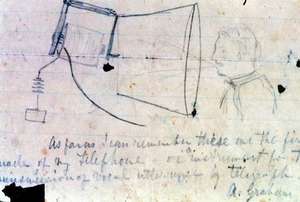
Source: https://www.britannica.com/technology/telephone
Medieval Flip Phones?
A look Into the Origin of Telephones
The telephone was first invented by Alexander Graham Bell in 1876. The word “telephone” comes from the two greek roots tele, “far”, and phone, “sound”. The word telephone was being used in conversation by children to describe a string telephone ias early as the late 17th century. This was long before the actual invention of a telephone in 1876. Although advancements in electronics have changed the physical design of the telephone countless times over the years, the functional design has stayed the same years after Bell’s time. The basic components of the telephone are a power source, a switch hook, a dialer, a ringer, a transmitter, a receiver, and an anti-sidetone circuit.

Source: https://www.britannica.com/technology/telephone
Bell’s first power source in experimental telephones used electromagnets activated by the speaker’s voice. This system was quickly changed, as it could not generate enough voltage to transmit speech to distant receivers. Instead, telephones began using batteries, until much later when current began being supplied through local switching offices.

The switch hook connects the telephone to its power source or direct current. In Bell’s first design the receiver was hung on a hook that operated the switch by opening and closing a metal contact . Modern day switch hooks have shifted to a handset and cradle.

The dialer is the system used to enter the number a caller wants to call. 14 years after Bell’s initial telephone, the traditional rotary dialer was born. The rotary dialer created pulses when turned, the number of pulses would signal the number being dialed. 70 years later push-button dialing was introduced.
Bell’s first ringer consisted of two closely spaced bells, a metal clapper, and a magnet. The movement of these mechanics would be activated by a current travelling through a coil of wire to create magnetic attraction, which would then be exerted on the schematics to create sound. The transmitter or ‘tiny microphone’ started in Bell’s time in the form of carbon transmitters. It was only half a decade later that telephone design began to switch to electrec transmitters.

Source: https://www.britannica.com/technology/telephone
Bell laid out invaluable groundwork for the telephone, many of which mentioned above, lasted for decades after his time. Bell’s research transcended his time, and with the help of many other minds, turned into the telephones we know today.
Sources:
Borth, David. “Telephone | History, Definition, Invention, Uses, & Facts.” Encyclopedia Britannica, www.britannica.com/technology/telephone. Accessed 3 Nov. 2021.
History.com Editors. “Alexander Graham Bell.” HISTORY, 30 Nov. 2019, www.history.com/topics/inventions/alexander-graham-bell.
Biography. “Alexander Graham Bell.” Biography, 9 Sept. 2019, www.biography.com/inventor/alexander-graham-bell.